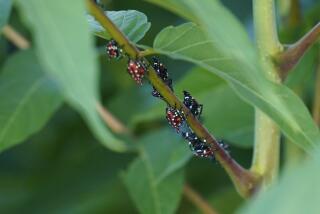Insects: They’re Little, but There Are a Lot of Them
- Share via
If that “Jeopardy” category is insects, here’s some general information:
* There are several hundreds of thousands of different insects in the United States. The only habitat they avoid is the ocean.
* Species in Orange County vary in size from less than a millimeter to 6 inches, but more than half are less than one-fourth-inch long.
* There are more insects in an acre than species of birds in the entire United States.
* The annual U.S. crop loss linked to insects is estimated at $3 1/2 billion.
* Insects are necessary too. They serve as agents in the pollination of plants. They produce honey, beeswax, silk and shellac, and are food for birds, fish and other animals. Some are used in the treatment of disease and the study of hereditary, evolution, stream pollution and biological problems.
* Insects have an enormous reproduction capacity: A female fruit fly can lay 100 eggs at a time 25 times a year. If not killed by pesticides or eaten by a bird, offspring can increase 10 to the 41st power. That means if you packed 1,000 fruit flies into a cubic inch, the offspring would extend 96 million miles in a year.
* Many insects can reproduce without a male. It’s called parthenogenesis.
* Eggs can hatch into more than one young. An insect can lay an egg case, where a whole mess of them come out.
Source: “Peterson Field Guide to Insects,” Donald J. Borror and Richard E. White (Houghton Mifflin, Co., $14.95).






